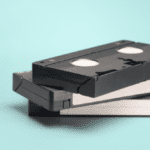 Politics
Politics  Politics
Politics  Pop Culture
Pop Culture 10 Celebs Who Have Surprisingly Wanted to Be on Reality TV
 Creepy
Creepy 10 of the Strangest Popular Creepypastas
 Animals
Animals 10 Animals That Used to Be Bigger
 Our World
Our World 10 American Cities, Towns & Villages That Are Unlike Any Other
 Movies and TV
Movies and TV 10 Huge Movies Almost Made by Other Directors
 Technology
Technology Lost in Transmission: 10 Unsung Heroes of Radio Innovation
 Miscellaneous
Miscellaneous 10 Incredibly Valuable Chinese Antiques Discovered by Accident
 Crime
Crime 10 Startling Cases of Jurors’ Mischief
 History
History 10 Facts about the Last Man to Be Hanged for Treason in the UK
 Politics
Politics 10 Dreaded Despots Who Met Untimely Deaths
 Pop Culture
Pop Culture 10 Celebs Who Have Surprisingly Wanted to Be on Reality TV
 Creepy
Creepy 10 of the Strangest Popular Creepypastas
Who's Behind Listverse?

Jamie Frater
Head Editor
Jamie founded Listverse due to an insatiable desire to share fascinating, obscure, and bizarre facts. He has been a guest speaker on numerous national radio and television stations and is a five time published author.
More About Us Animals
Animals 10 Animals That Used to Be Bigger
 Our World
Our World 10 American Cities, Towns & Villages That Are Unlike Any Other
 Movies and TV
Movies and TV 10 Huge Movies Almost Made by Other Directors
 Technology
Technology Lost in Transmission: 10 Unsung Heroes of Radio Innovation
 Miscellaneous
Miscellaneous 10 Incredibly Valuable Chinese Antiques Discovered by Accident
 Crime
Crime 10 Startling Cases of Jurors’ Mischief
 History
History 10 Facts about the Last Man to Be Hanged for Treason in the UK
10 Things Your Ancestors Did Better Than You
We have a rather arrogant quality about ourselves in these modern times. We seem to truly think we have reached the acme of human society. Well, I hate to be the one to disabuse you of that notion, but I’m going to . . . Almost everything we do has been done better before us. Our ancestors hold the key to solving many problems of modern society and this list looks at those solutions.
See Also: Top 10 Reasons We Should Revive the Dark Ages
For clarity, when I say “ancestors” I mean the generations up to (roughly) the time of the end of World War II; for most us that means our great (or great-great) grandparents: modern people—just not as modern as us.
10 Save The Planet

While the most common plastic today (polyethylene) was actually invented in 1898, it didn’t go into general production until the 1930s. It was then that ICI opened the world’s first manufacturing plant—on the same day Adolf Hitler invaded Poland: September 1st, 1939.[1]
Nevertheless, it wasn’t until the 1960s that the production of plastic on a mammoth scale became truly viable. Since then . . . well, you know what happens next because you’re living in it. Ubiquitous products like straws, bags, mass-produced trinkets, and the many objects used in our daily lives, have led to a pollution nightmare. And the stuff we don’t just toss in the trash ends up in the dump anyway because of the high cost of recycling.
So what did our ancestors do? They stored their goods in glass containers which were then re-used. Most food was produced at home so waste was almost non-existent. We seem to be perpetually trying to find solutions to our modern problems with only one caveat: it must make someone a lot of money and it must not imply that things in days gone by were good. The way we once lived has many solutions to our modern problems but we seem dead-set against them.
This might also be a good time to correct an error from a previous list written in 2010: Top 10 Places You Don’t Want To Visit. On that list I discuss the great pacific garbage patch. Since writing that list, much information has come out about the patch. The reality is: it is basically a myth. Yes there is a concentration of micro-plastic under the surface, but it turns out the definition used to describe the “extremely high” concentration of plastic was somewhat open to interpretation and in our eagerness to point out the evil we had done to the ocean, no one seemed to notice that the “highest concentration of microplastic is around three pieces of plastic the size of a pencil eraser in a cubic meter.”[2] Oops. The photo of a giant patch of trash with men in boats is actually taken off the coast of the Philippines.
9 Live Within Their Means
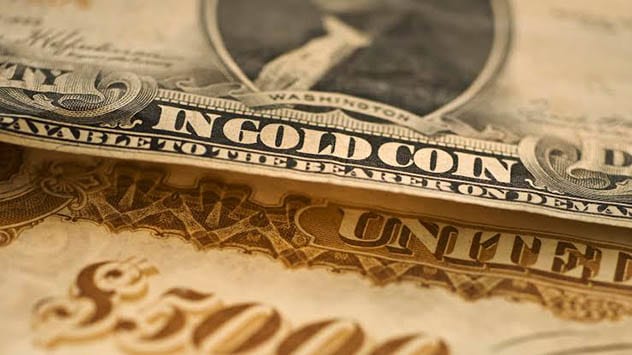
In 1944 the Bretton Woods system was created in which instead of countries redeeming their money for Gold, they would redeem for US dollars. This made the US dollar the new form of gold in a sense. The US dollar was pegged to the value of gold still and that was meant to keep the system stable while allowing things like the newly invented International Monetary Fund and the World Bank to have a little more flexibility in the creation of money. And then in 1971 it all fell apart. President Nixon ended the connection between gold and the US dollar and the printing presses began to roll full steam ahead.[3] From that moment on, we began living off the earnings of the future. The reason our lives today don’t look like pages out of a book on the Great Depression is that we have all been made artificially rich. The terrifying thing is that it is all going to come crashing down—we just don’t know when.
So in the times before these systems were put in place, people earned money from their labour, and they saved that money. And when they needed to buy something, they used the money they had saved. They did not use a Visa to pay for it with income from the future. They didn’t use installment plans, and they didn’t use equity in their homes to buy new drapes! At the very most they may have done a lay-away which allows you to buy something on time payments, but unlike an installment plan, you didn’t get the goods until you had paid in full. Delayed gratification is a far better thing than the instant type we are all used to now. Funnily enough, even layaway was considered bad until the newly created Federal Reserve bank (a private company in the US)[4] caused the Great Depression; it was then that layaway emerged.
The long and short of it is this: if you revert to the old ways of spending, you will be far richer than your neighbors. Use a system like the snowball method of debt reduction to eradicate your credit cards and installment plans and start living in the now. You can learn how to do that on Top 10 Tips For Achieving Financial Freedom which I wrote in 2007.
8 Improve Their Mind

Books. Simple as that. We all have access to them—but instead of reading we stare at glowing pieces of glass all day. It is all well and good to fill your phone with apps like Google Books and Kindle, but it is hard to resist the pull of the thumbs-up on a photo of your latest cafe lunch or clothing purchase at The Gap. Why bother reading about “shirts of sheer linen and thick silk and fine flannel, which lost their folds as they fell and covered the table in many-colored disarray”[5] when you might get 15 likes on your photo of that funky political tee-shirt you wore today? “O quantum est in rebus inane!”[6]
There are many ways we can mimic our ancestors in terms of improving our minds; the first is to abolish the use of our electronic devices for at least a small part of the day. Set aside an hour to read a book—any book will do, though obviously I recommend The Ultimate Book Of Top 10 Lists by us! When you become engrossed in a good book, your mind opens up in a myriad of ways. Your rational and emotional minds need to be tended but more importantly perhaps is your imagination. It is from the imagination that so many great creations of man have come,[7] and movies and social media posts prevent the use of the imagination, replacing it instead with the ideas from another’s mind. You might be in possession of the brain that will invent the next great concept in human development, but you’re too busy scrolling through pics of incredibly hilarious sports photos to notice.
7 Eat

I might be sounding like a broken record at this stage, but in brief: the US government made everyone fat by advocating a ridiculous pro-vegetarian anti-fat diet in the 1960s and 1970s. Now that that is out of the way, the history of eating: breakfast didn’t exist as anything more than a drink or snack until the 19th century[8] and luncheon was the main meal of the day for most (this is all in reference to European culture of course). Then the Seventh Day Adventists got us eating cereal every day, the government got us eating chemical margarines instead of butter and fat, and the media (fake news long before the president used the term) sold us on coke and other delights. This is not to say there weren’t fat people before these things occurred, but, frankly, these days obesity seems to be less the thing to avoid and more the goal.
How do we fix this? When virtually everything the media promotes or says is to enrich someone . . . we should certainly not advocate for anything recommended or endorsed by them. That means no diet fads. There is one place the media hates: the past. The answer to eating right is to mimic the behavior of our ancestors (and I am not meaning restrictive Paleolithic diets). Edwardians were similar to us. They had grocery stores,[9] cars, and other fairly modern trappings of life. Perhaps the answer is to simply reject any dietary advice from beyond 1940 until someone without an ulterior motive funds some genuine studies into the ideal human diet. Just say no to diet myths.
6 Exercise
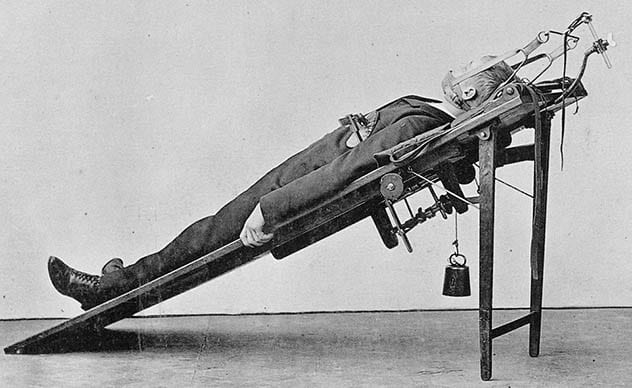
So you need to lose a few pounds or improve your health. What do you do? Sign up for a decade long membership (“it was the best price!”) at a fancy gym and then attend one session. Yup: just the one. We have somehow been programmed with this awful notion that exercise is best done indoors and intensely for a short period of time. But our thinner (and probably longer-lived—if we exclude child mortality from age of death statistics) ancestors knew better.
While the photo above is incontrovertible proof that some evil madman in the Victorian times took inspiration from the tools of the Spanish Inquisition to devise the most horrific of all torture devices man would ever know: gym equipment, don’t be fooled! Our predecessors didn’t, as a general rule, take their exercise in this rigid manner. They simply walked everywhere they went and did the hard jobs themselves. Doing the laundry took all day[10] and the average housewife (unless she could afford a maid) would call upon her friends to assist. My own father as a child was required once a week to jump up and down on the sheets in a copper kettle full of boiled water and soap (I’m not a boomer: my parents were old when they had me).
How can we learn from our ancestors and ditch the gym membership? Add an hour a day (in addition to your daily reading hour as mentioned above) to walk around your neighborhood. Smell the flowers. Say hi to the guy with the Trump 2020[11] sign in his yard. Help an old lady across the street. You will find that not only does your health improve, but so does your relationship with your neighbors and you may even find it makes you a nicer person online! If you are particularly courageous, you might want to consider doing some shopping at the same time. It is certainly better to carry a can of beans around for an hour than spend 10 minutes sweating indoors with a dumbbell.
5 Have Manners
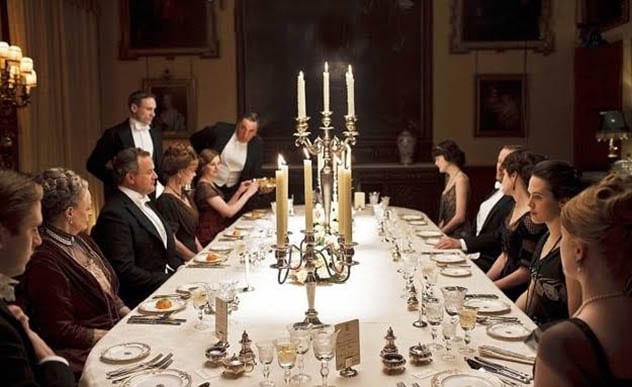
Long gone are the days of writing thank you notes[12] for gifts. In some cases people don’t even bother with thank you notes for wedding gifts which was, for most people, the last remnant in society of formal thank yous. Once upon a time (not so long ago), a thank you note was issued for a million different reasons. If someone gave you a gift, you wrote a note. If someone had you to dinner, you wrote a note. It was the height of bad manners not to make the effort to thank a person for the effort they had gone to for your pleasure. It makes a lot of sense really. But alas, out comes those shiny bits of glass again and the most you can expect these days is a “thanks!” on instagram or snapchat (or Facebook if you are elderly).
In other areas of society manners were also far better than now. If you were invited to a meal at someone’s house, you always reciprocated at a later date by inviting them to your own home or a restaurant. And if you did invite them to a restaurant, the person who invited the guests paid for everyone’s meal. That’s right! You didn’t split the bill when you were the host. Just as you don’t charge your friends for the cost of the food when you cook at home, you shouldn’t in a restaurant. Admittedly things were a little different then: if you hosted you might also have ordered a particular menu for everyone at the table so you could plan for the cost, but there is no reason you couldn’t follow this nice old rule of good manners[13] these days with real friends who you can presume won’t take advantage of you.
4 Build
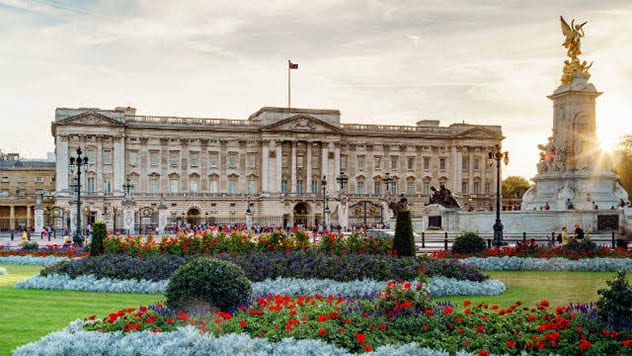
New construction regulations coupled with new building materials (such as styrofoam, plastics, and various metals) have meant that we can build houses much faster and more unconventionally than we have in the past. But the end result is sometimes buildings which can simply not stand up to age, the weather, or natural disasters in the same way as old construction built with stone and timber.
One good example of this was the Christchurch earthquake in 2011.[14] In that old city, 60% of the deaths were the result of the collapse of the modern CTV building, and while many of the old buildings were later condemned, they stood up to the quake better than those built with strict earthquake guidelines but new building codes. Next time there’s a big one, I sure as heck hope I’m in an old Victorian building.
And don’t even get me started on how hideous a lot of modern buildings look in contrast to the beautiful neoclassical facades[15] that came to be the dominant form of buildings in London and Paris, and the inspiration for much of the beauty in American Colonial construction. Granted there are some occasional modern buildings that are quite beautiful in their own unique way, but by and large giant concrete towers filled with glass can’t really compete with the likes of Buckingham Palace (pictured).
3 Teach and Learn

The moment that colleges began to teach that there is no objective truth, they revoked their own remit to educate. If there is no objective truth, there is no reason to teach.[16] You can now watch video after video on YouTube of young university students who don’t know who Adolf Hitler was (but will call you a Nazi if they don’t like your opinion). Feelings surpass facts,[17] and the entire history of western civilization is rendered down to, and described as, “white male patriarchy”, in a tone that is palpably hateful.
I am not even going to begin to try to describe a solution to that mess. It simply needs to be abolished. But when that day comes perhaps we can think about the classical education that was given to those who came not so long ago.[18] A modern education system but grounded in the Trivium and Quadrivium of the ancients. Not only did the ancients themselves come up with some of the greatest notions in man’s history, the successive generations through the Middle Ages expounded upon them. And then in the late 20th century we burnt it to the ground. Perhaps it is time to bring it back.
2 Create Art

There will be, in time, a list about modern art and its decline (some would obviously not agree that it is indeed a decline). But until then we shall content ourselves with this brief declaration: modern people don’t know how to “art”. What passes as fine art these days is astonishingly bad. Bottles of human urine with sacred objects in them, excrement smeared on canvases, and even an unmade bed are lauded as fine things.[19] Of all the items on this list, art is single-handedly the most extreme example of the differences between our ancestors and us.
Pretty much all art up until the 1900s is beautiful (and some beyond into the early stages of the 20th century). But at some point we got sidetracked and art ceased to be about beauty and became an expression of novelty or shock. Aristotle’s concept of mimesis (artistic mimicry) states that “art is not only imitation but also the use of mathematical ideas and symmetry in the search for the perfect, the timeless[.]”[20] We now live in a postmimetic world in which the ruination of the perfect is sought. And judging by some of the dreck we see on social media and in the news, Oscar Wilde rather presciently said “[l]ife imitates Art far more than Art imitates Life”.[21]
1 Have Fun
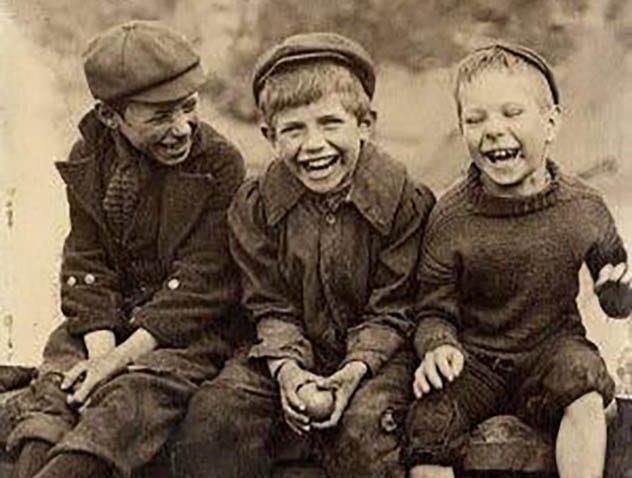
If future generations looked at an Apple advertisement, they would believe that we lived in one of the most fun-filled times.[22] The ads are full of laughing groups of divers friends exploring all manner of fun hobbies. But the whole thing is contrived; the reality of our time is that we dutifully go to work, earn the money needed to take the occasional holiday, and spend a lot of time online getting rather upset at other people’s opinions and feelings. And then we lap up mainstream movie interpretations of the likes of Charles Dickens’ books filled with dour and ugly old women beating children or crippled men with misery in every line drawn across their face.[23] Perhaps this allows us to be thankful we aren’t them. Perhaps it lulls us with a false sense of comfort against the miserable parts of our own lives.
But life for the Victorians (and the generations before them) was anything but bleak. They lived in a time of discovery and invention. Museums opened to the public for the first time and the great exhibition was held in a glittering crystal palace.[24] The delightful fairy tales that Disney so loves to wreck were penned and adored by happy children. The ghoulish tales of goblins and ghosts thrilled even the strongest of men. The homes were filled with the smells of exotic fruits and spices from mysterious lands newly colonized, and optimism filled the air like the clouds of incense that filled their churches. Those were the days.
For more lists like this, check out 10 Ways Young Generations Are Better Than Their Parents, and Top 10 Reasons Life Was Better In the Fifties.




